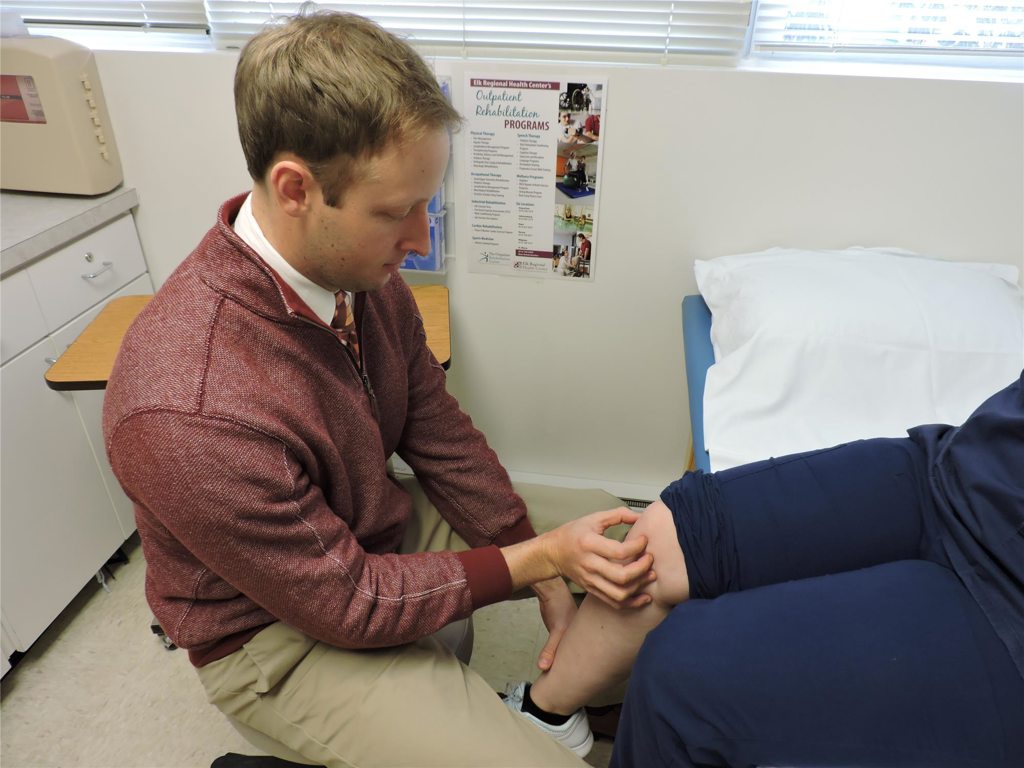
Cooled Radio Frequency Treatment Available for Osteoarthritis
Osteoarthritis, or OA, sometimes referred to as degenerative joint disease or even “wear and tear” arthritis, affects more than 30 million adults in the United States and nearly 30 percent of adults in Pennsylvania, according to the Centers for Disease Control and Prevention, or CDC. Caused by the damage and breakdown of the cartilage between bones, OA can lead to joint pain, swelling and stiffness.
Because OA affects joints, many people suffer from chronic knee pain due to the disease. Although typically treated with a combination of methods, including medications, physical therapy or even surgery, many people diagnosed with OA of the knee still experience the pain and subsequent limitations to their lifestyle.
“The treatments that have been offered and available to patients for chronic knee pain and OA have helped some, but have not provided a significant long-term relief,” said Dr. Timothy Vollmer, pain management specialist at the Penn Highlands Interventional Pain Center in St. Marys.
But, according to Vollmer, a new treatment he is utilizing called cooled radio frequency ablation, often referred to by its brand name, “Coolief,” could be the answer many diagnosed with chronic knee pain have been seeking. “With the cooled radio frequency treatment there is evidence that patients have been helped significantly, meaning a 50-90 percent reduction of pain that is expected to last between six and 18 months,” Vollmer said.
Dr. Maureen Ginsburg, pain management specialist at the Penn Highlands Interventional Pain Center in Brookville and Punxsutawney, said that the cooled radiofrequency treatment is “a great alternative for the population of patients who suffer from chronic knee pain but are not candidates for surgery.” She added, “even patients who have already had knee replacement surgery and still experience pain could benefit from this procedure.”
So, what is Coolief and how does it work?
The cooled radiofrequency treatment is a minimally-invasive, outpatient procedure. During this procedure, a probe is inserted into the tissue in the knee to target the sensory nerves responsible for the pain and deactivate them, which results in relief from the pain.
“Because these are sensory nerves, patients will not experience any muscle weakness after the procedure,” said Ginsburg. “It’s important to note that this is not a joint injection and it is not a steroid.”
“While no treatment is perfect, and it is incredibly difficult to totally eliminate pain, the cooled radio frequency method, when it works well, certainly has fewer side effects compared to other methods. It has been proven to yield greater pain relief compared to steroid injections,” added Vollmer. “There is no guarantee that any method will work for everyone, but it can certainly be life changing for a lot of patients.”
So, how do you know if this procedure is right for you?
If you suffer from chronic knee pain and either want to avoid knee replacement surgery or are not a candidate for surgery, or if you have been unsuccessful with other methods of treatment, consult your primary care provider.
“Once a patient obtains a referral from their doctor, we can meet to discuss their history and the other treatments they have tried,” said Vollmer.
The next step is to conduct a diagnostic evaluation, according to Ginsburg. “In the diagnostic testing phase, we start with one or two nerve blocks. If the block results in a response greater than 50 percent of pain reduction, we can proceed and schedule the cooled radiofrequency procedure,” she said.
“During the diagnostic block, patients are awake and never sedated so that the results are not skewed by the effects of anesthesia,” said Vollmer. “We then look for that 50 percent improvement in pain to indicate the likelihood of success with the cooled radiofrequency procedure.”
On the day of the cooled radiofrequency ablation, a patient’s preparation may vary depending on their pain management specialist. For Ginsburg, she says that she does not sedate her patients for the procedure, which means patients will be able to eat, drink and take their regular medications prior to the procedure. Vollmer, on the other hand, does provide moderated sedation, so his patients would have to prepare accordingly.
Following the procedure, our experts said that patients will be sore for 24-48 hours and can use ice packs and anti-inflammatory medicine to help recover. “Within 72 hours the pain from the procedure should significantly decrease and, we hope, the chronic pain associated with the knee arthritis will be drastically reduced,” said Vollmer.
While the cooled radiofrequency ablation does not cure OA, our experts believe that patients will notice significant pain relief for periods of 6-12 months on average, resulting in increased mobility and improvement in quality of life.
“The greatest risk is that it doesn’t work,” said Vollmer. “Compared to living with chronic pain, that is often a risk worth taking.”
For more information about the Penn Highlands Interventional Pain Center, contact Dr. Vollmer’s office in St. Marys at 814-788-8577 or contact Dr. Ginsburg’s office in Brookville at 814-849-1436 or in Punxsutawney at 814-375-4045.
